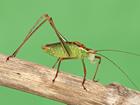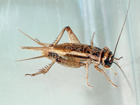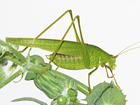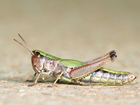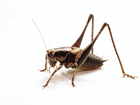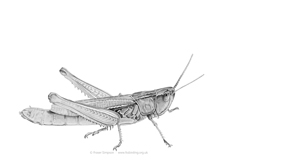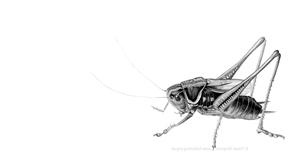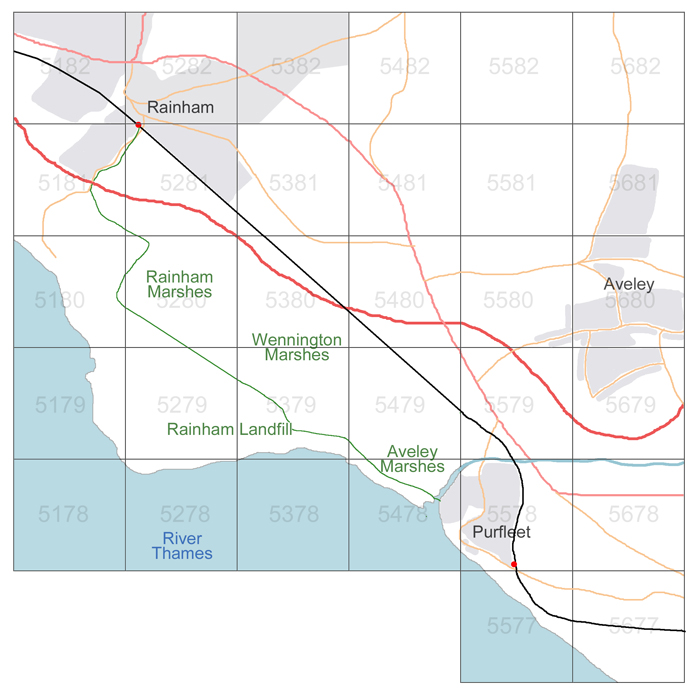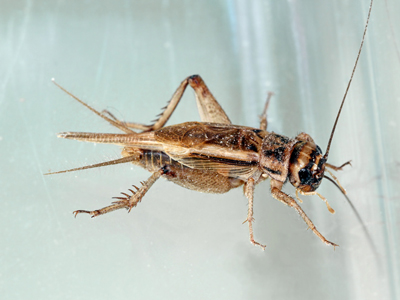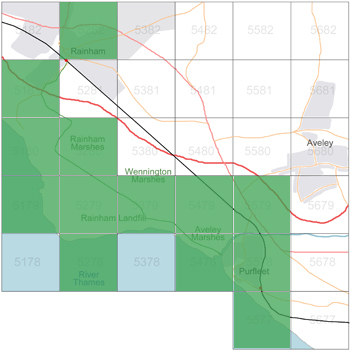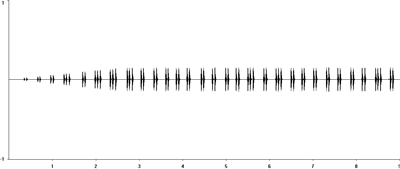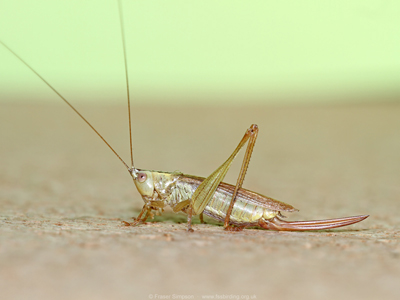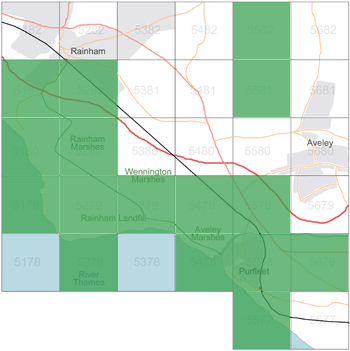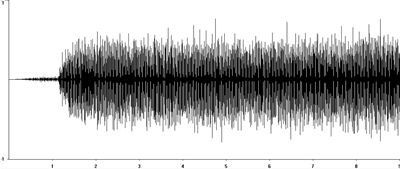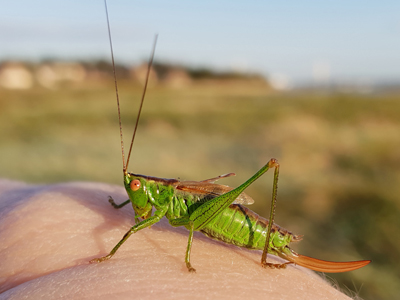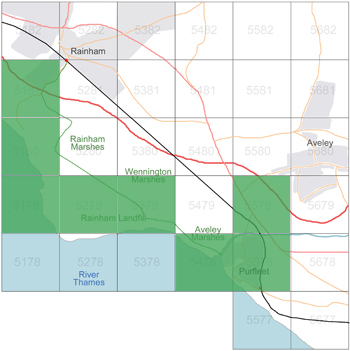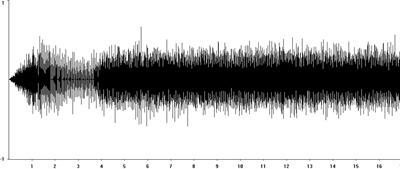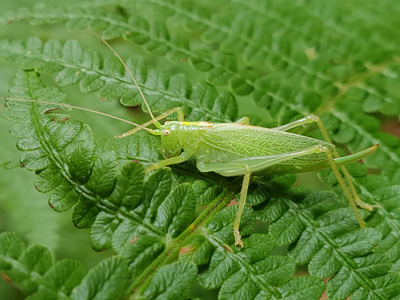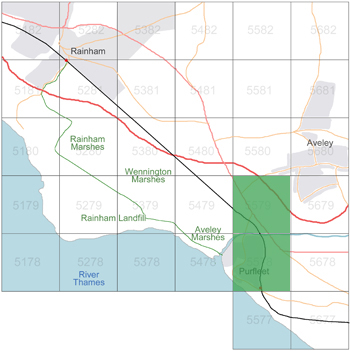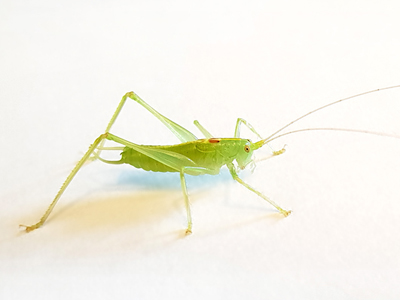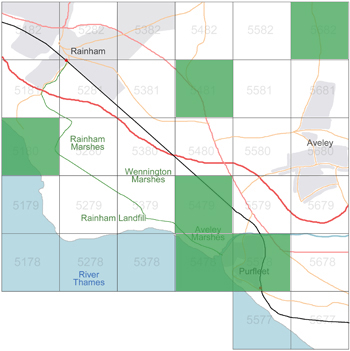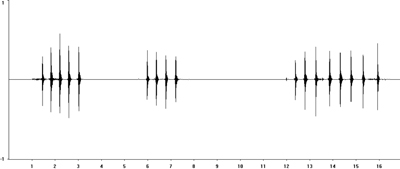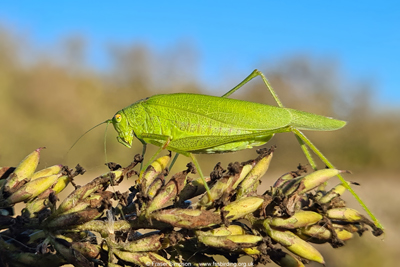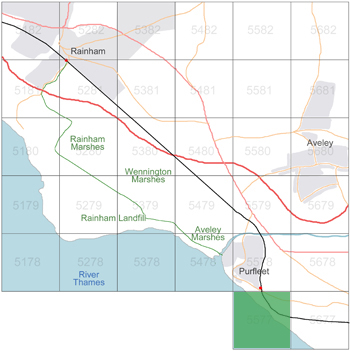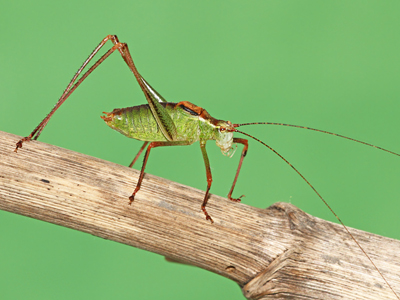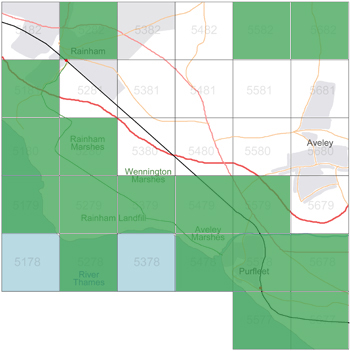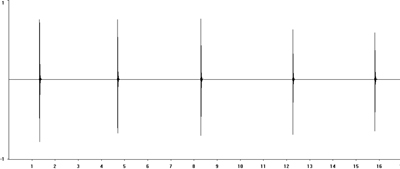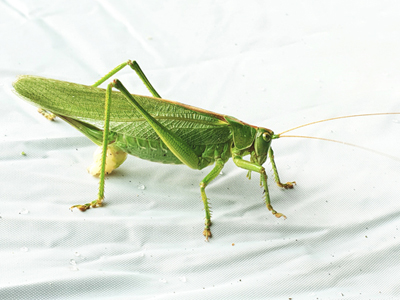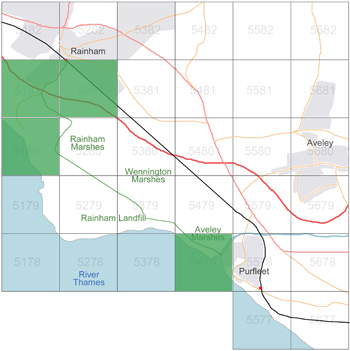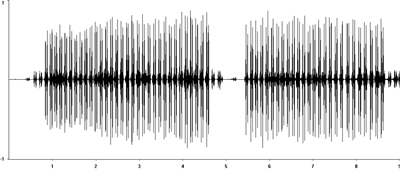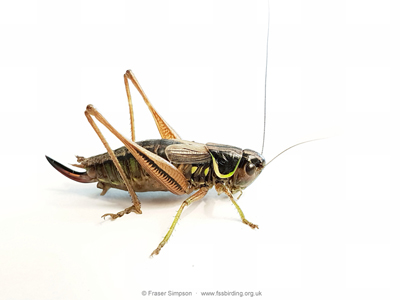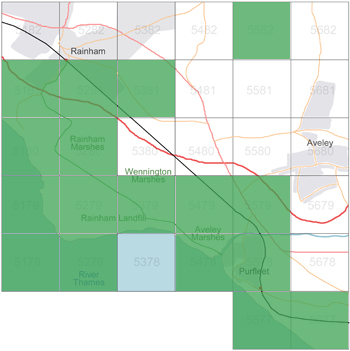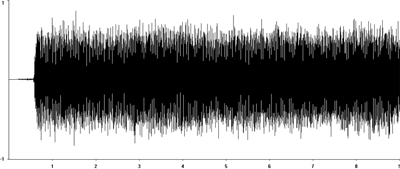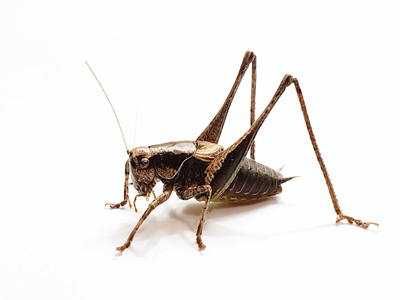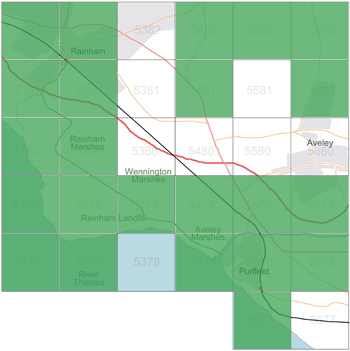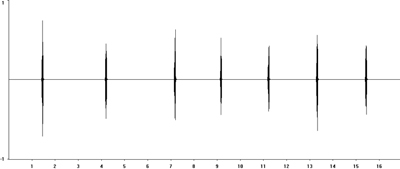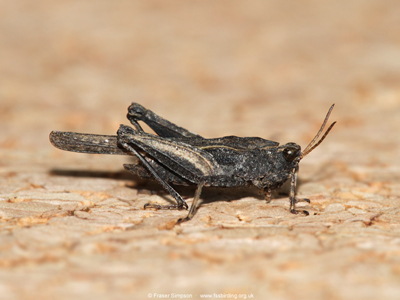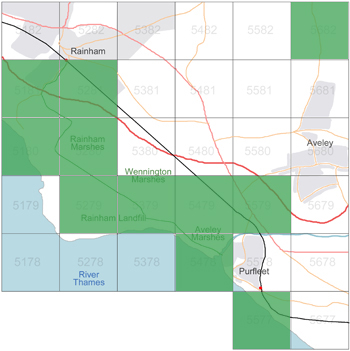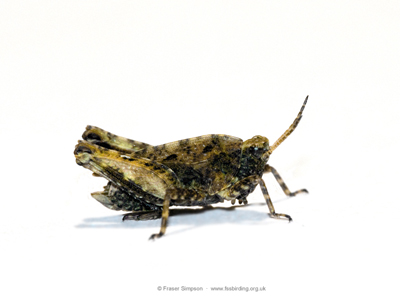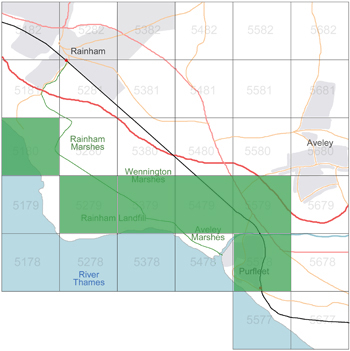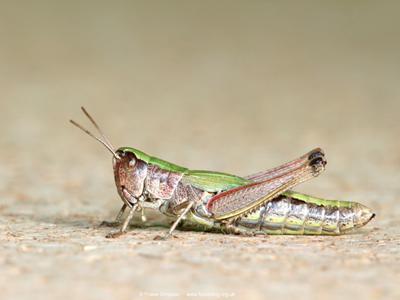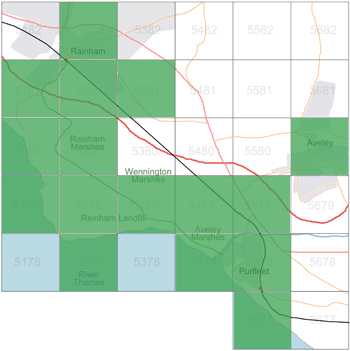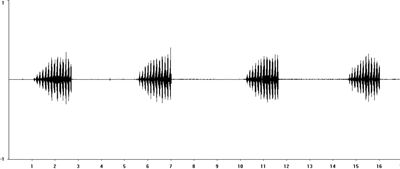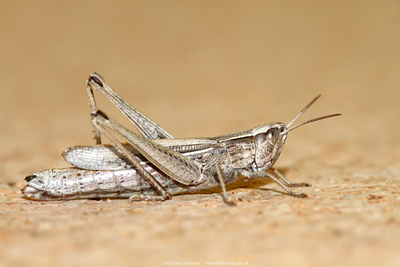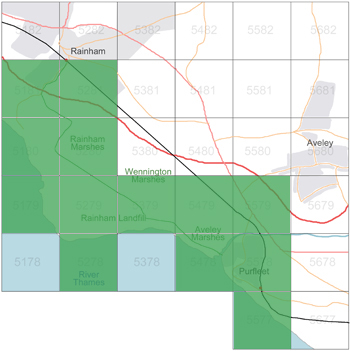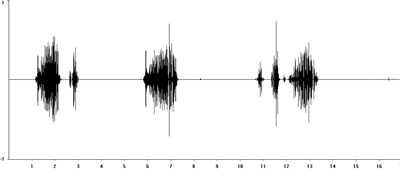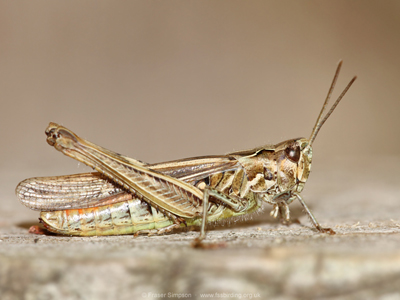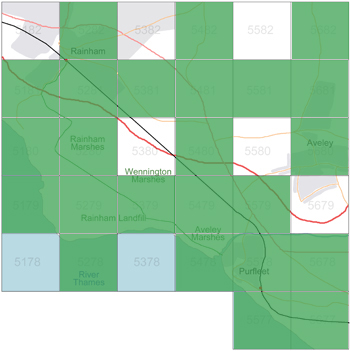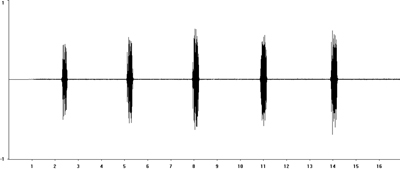|
|
|
|
Home | Trip Reports | Recent Sightings | Blog | Photographs | Phonescoping | Sounds & Sonograms | Sketches | Patches | Butterflies & Dragonflies
|
|
|
| Grasshoppers, Crickets and Bush-crickets of Purfleet & Rainham |
The Purfleet and Rainham area in South Essex (vice-county 18) on the north bank of the River Thames has 15 species of orthoptera; 13 native, two adventive and one long-established alien. These comprise one cricket (Gryllidae), nine bush-crickets (Tettigoniidae), two groundhoppers (Tetrigidae) and three grasshoppers (Acrididae).
The local area is a heterogeneous mosaic of industry and semi-natural habitats comprised of urban, industrial, landfill, brownfield, scrub, wetland, grassland and restored grazing marsh. There are small areas of saltmarsh, ponds, ditches, reedbeds, silt lagoons, small rivers (Ingrebourne & Mardyke) and chalk pit. There is virtually no woodland in the area except for Watts's Wood.
The species profiles below summarise information on distribution, habitat, food, phenology and song, with much of it from personal observations and recording between 2018-2023. This effort has mainly focused on the southern and western half of the area between Purfleet and Rainham. In addition to field work, lab work observations of many of the species has been carried out in insectariums at home.
Distribution & Local Status: Indicates where the species has been found in the 30 square kilometres in the mapped area below, and historical changes if known. Habitat: States which local habitat types the orthopteran occurs in, in the Purfleet-Rainham area. Food: Describes what the species eats in the wild, with some observations from feeding captive, wild-caught individuals in an insectarium. Phenology: Months when the adults are active and likely to be found. Nymphs will be found earlier in the season, though a mix of nymphs and adults will occur together during some transitional period. Song: Description of what the calling song sounds like, when it can be heard, and if a bat detector is useful (for ultrasonic species). Sound recordings of stridulations were made in the field in the local area, or from captive males in an insectarium.
Gryllidae: Gryllinae House Cricket Acheta domesticus
Distribution & Local Status: Long established non-native. Small numbers occur around the landfill annually where a core population survives and breeds. Numbers increase and become more widespread in hot summers when it spreads out to urban areas and reproduces, e.g. 50+ stridulating males around the edge of landfill 23-26 August 2022; nymphs around Harrisons Wharf, Purfleet on 26-28 August 2022. Habitat: Grassland and bare ground around Rainham landfill. Crevices in wharfs, and pavement cracks in urban areas. Also on new industrial development on brownfield sites. Food: Omnivorous. In captivity, wild-caught individuals consumed fruit, vegetables, oats, bran cereal and bread. Phenology: Adults heard mainly between late June and early October.
Song: The calling song is a loud, far-carrying melodic chirp around 4 kHz, repeated in a long series of echemes consisting of 2-4 syllables. Sings in the evening, into the night. Sounds exotic for the area.
Oscillogram of Acheta domesticus calling song
Other information: Females are attracted to ultraviolet light, e.g. four to a 20W Actinic Heath moth trap on 24 Aug 2022. This species is much less likely to be sold as pet food for reptiles now as commercially reared stocks are prone to being wiped-out by the Acheta domesticus densovirus (AdDNV). In the UK, Southern Field Cricket (Gryllus bimaculatus), Jamaican Field Cricket (Gryllus assimilis), Tropical House Cricket (Gryllodes sigillatus) are all sold and sound similar to House Cricket (Acheta domesticus).
Tettigoniidae: Conocephalinae Long-winged Conehead Conocephalus fuscus
Distribution & Local Status: Fairly common and widespread. Occurs throughout the area in long grassland. Formerly restricted to the central south coast of England, its range expanded rapidly north through England in the late 20th century. Habitat: Found in rough grasslands, brownfield grasslands, wetlands, ungrazed meadows, unmown path and roadside verges. Food: Omnivorous, mainly vegetarian. In captivity, wild-caught individuals consumed cucumber and rushes. Phenology: Adults can be heard from late July to early November.
Song: The calling song is a rapid (~28 elements/sec) high-pitched shuffling produced in long bursts (up to 100+ sec). Sings during the day and into the early night. Best heard with a bat detector at 30 kHz.
Oscillogram of Conocephalus fuscus calling song
Tettigoniidae: Conocephalinae Short-winged Conehead Conocephalus dorsalis
Distribution & Local Status: Fairly common but localised. Distributed mainly along the riverside, particularly Aveley Bay and the bay at the 'Concrete Barges' just south of the rice factory. Habitat: Occurs locally in wetlands with club-rush (Schoenoplectus) and in saltmarsh patches along the River Thames. Food: Omnivorous, mainly vegetarian. In captivity, wild-caught individuals consumed cucumber and grasses. Phenology: Adults can be found from late July to mid October.
Song: The calling song is a rapid, almost inaudible, high-pitched hissing produced in very long bursts (100+ sec), interspersed with quieter 'half-speed' ticking sections like the free-wheel of a bicycle. This two part song is softer than that of the Large-winged Conehead. Sings during the day. Best heard with a bat detector at 30 kHz. In captivity, a wild-caught male stridulated in very long bursts of up to nine minutes without a break at 25.4°C ambient room temperaure (no heat lamp or direct sun).
Oscillogram of Conocephalus dorsalis calling song
Tettigoniidae: Meconematinae Oak Bush-cricket Meconema thalassinum
Distribution & Local Status: Local and scarce due to the lack of mature broadleaved trees in the area. Probably under-recorded due to its elusive nocturnal and arboreal behaviour. Habitat: Broadleaved woodland, particularly Oaks (Quercus). Food: Insectivorous. Phenology: Adults appear in late July, persisting in to late autumn.
Song: The virtually inaudible calling song is produced by the male drumming a leg on a leaf in short, rapid bursts (percussion, not stridulation). Sings at night.
Tettigoniidae: Meconematinae Southern Oak Bush-cricket Meconema meridionale
Distribution & Local Status: Due to its elusive nature this species is not easily found without beating branches and Ivy. Probably more common and widespread than records suggest. An adventive species, first found in Britain in 2001. Habitat: Trees and shrubs including Willow (Salix) and Holly (Ilex), and walls covered with Ivy (Hedera). Food: Insectivorous. In captivity, wild-caught nymphs and adults consumed live lesser fruit flies (Drosophila). Phenology: Adults can be found from late July into late autumn.
Song: Does not stridulate. The virtually inaudible calling song is produced by drumming a leg on a leaf. In captivity, a wild-caught male produced a series of 3-8 abrupt (100ms), low frequency percussive sounds (0.1-1.4 kHz) on Ivy leaves in the presence of a female. At peak activity it produced 11 drumming bursts in one minute (at 25.1°C ambient room temp). Drumming bursts lasting between 0.8 and 3.6 secs. In a silent room at night, I could hear the drumming taps of this male with unaided ears. Sings at night.
Oscillogram of Meconema meridionale calling song
Other information: Females are attracted to ultraviolet light; annual in my 20W Actinic Heath moth trap.
Tettigoniidae: Phaneropterinae Southern Sickle-bearing Bush-cricket Phaneroptera nana
Distribution & Local Status: A small population of this adventive species persists on a brownfield site on the River Thames, south of Purfleet railway station, having possibly colonised via a container ship at least since 2018. At this site it is very localised and not found nearby in virtually similar habitat. Habitat: Browfield site with Buddleia (Buddleja davidii), Bramble (Rubus fruticosus) and Traveller's Joy (Clematis vitalba). Food: Vegetarian. In captivity, a wild-caught pair consumed most flowers with a preference for Buddleia (B. davidii). Later consumed buddleia leaves and pear fruit slices when buddleia stopped flowering at the end of October. Phenology: Adults present from August to early November.
Song: The calling song is a single, faint, largely ultrasonic syllable repeated every 0.8-1.4 seconds. Mostly inaudible to human ears, except at very close range in quiet conditions. Males observed singing from Buddleia and Bramble. Much louder with a bat detector set to 16-20 kHz. Sings from sunset and through the night. A wild-caught captive male stridulated throughout one night in bouts (49 bouts in 6h) of 30 seconds to 17.5 minutes (total 747 syllables/17.5 mins; ave 1 syllable/1.4 sec) with 4-6 elements per syllable. Each syllable 65-100 milliseconds.
Oscillogram of Phaneroptera nana calling song
Tettigoniidae: Phaneropterinae Speckled Bush-cricket Leptophyes punctatissima
Distribution & Local Status: Common and widespread, though not frequently seen unless searched for. A bat detector will reveal their presence in late summer and early autumn where every bush in some areas will hold one or more stridulating males, e.g. 29 males heard along the footpath/cyclepath (NCN Route 13/136) west of Purfleet on 10 October 2023. Habitat: Frequents Willows (Salix), scrub, Bramble, Buddleia and Ivy patches anywhere in the area including wetlands, gardens and brownfield sites. Attracted to light at night so often found around porch and security lights, or moth traps. Food: Vegetarian. In captivity, wild-caught individuals consumed Bramble leaves, salad leaves and cucumber. Phenology: Adults are active from late July to early November.
Song: The calling song is a single, quiet, largely ultrasonic syllable repeated every 3-4 seconds. Best heard with a bat detector set to 40 kHz which transforms the sound into a loud audible tap. Sings from late afternoon into the night. One wild-caught captive male was recorded stridulating 758 times in 60 minutes.
Oscillogram of Leptophyes punctatissima calling song
Tettigoniidae: Tettigoniinae Great Green Bush-cricket Tettigonia viridissima
Distribution & Local Status: Scarce and localised. A very small colony persisted in a scrub patch in Ferry Lane Industrial Estate until it was cleared for development. While this species fails to establish itself in the area, immigrants from Crossness, just across the river in Kent, are likely to be the source of the occasional records in the area. Habitat: Scrub, particularly those with large unmanaged Bramble (Rubus fruticosus) patches. Food: Omnivorous. In captivity, wild-caught individuals consumed cucumber and green lacewings (Chrysopidae). Phenology: Adults have been heard from late July to early October.
Song: The calling song is a loud, far-carrying high-pitched sewing machine-like sound (~10 double-element syllables/sec at 18°C). Sings from late afternoon into the night and can be heard a considerable distance away.
Oscillogram of Tettigonia viridissima calling song
Tettigoniidae: Tettigoniinae Roesel's Bush-cricket Roeseliana roeselii
Distribution & Local Status: Fairly common and widespread. Occurs throughout the area in long grassland. Formerly restricted to the south and east coasts of England, its range expanded north and west through England in the late 20th century. Habitat: Found in both long, dry and damp undisturbed tall grasslands, including those with a low, sparse scrub component. Food: Omnivorous, mainly vegetarian. In captivity, wild-caught individuals consumed salad leaves, cucumber and grasses. Phenology: Adults can be heard from late June to early October.
Song: The calling song is a very rapid, high-pitched continuous 'electrical' buzzing lasting minutes-on-end (and louder than coneheads), with only occasional pauses. Sings during the day but often heard into the night on very warm evenings.
Oscillogram of Roeseliana roeselii calling song
Tettigoniidae: Tettigoniinae Dark Bush-cricket Pholidoptera griseoaptera
Distribution & Local Status: Common and widespread. Large numbers can be heard along the footpath/cyclepath (NCN Route 13/136) between Purfleet and Rainham, e.g. 166 males on 10 August 2020. Habitat: Scrub, particularly dense Bramble (Rubus) patches. Also thicker and coarser herbage along pathsides with Stinging Nettles (Urtica dioica). Food: Omnivorous. In captivity, wild-caught individuals consumed cucumber, carrot, oats, bran cereal and spiders. Phenology: Adults can be heard from late July to late October, and sometimes until mid-November in frost-free autumns.
Song: The calling song is a fairly loud, short zirt (~90 msec) repeated every 1-2 seconds. Mainly sings from early evening into the night, though heard at other times of the day.
Oscillogram of Pholidoptera griseoaptera calling song
Tetrigidae: Tetriginae Slender Groundhopper Tetrix subulata
Distribution & Local Status: Occurs in damp areas adjacent to the river and around wetlands inland. Underrecorded due to its small size and elusive habits. Habitat: Prefers open damps areas with exposed mud and short grassland in wetlands. Food: Herbivorous; mosses, lichen and aglae. In captivity, wild-caught individuals consumed mosses and cucumber. Phenology: Adults can be found throughout the year but are most likely in early spring and late summer. Nymphs and adults survive through the winter.
Song: Not known to produce sound. Other information: Best found by getting down low and visually searching damp areas, or by sweep-netting.
Tetrigidae: Tetriginae Common Groundhopper Tetrix undulata
Distribution & Local Status: Occurs in damp areas adjacent to the river and around wetlands inland. Underrecorded due to its small size and elusive habits. Habitat: Open and shaded damp areas rich in moss along with bare ground. Food: Herbivorous; mosses, lichen and aglae. Phenology: Adults can be found throughout the year, with nymphs in spring and summer.
Song: Not known to produce sound. Other information: Best found by getting down low and visually searching damp areas, or by sweep-netting.
Acrididae: Gomphocerinae Meadow Grasshopper Chorthippus (Pseudochorthippus) parallelus
Distribution & Local Status: Common and widespread. Habitat: Occurs in most long grassland in the area. Particularly abundant in long, uncut damp areas around wetlands. Does not occur on mown or sprayed grassland. Food: Vegetarian. In captivity, wild-caught individuals consumed most local grasses. Phenology: Adults may be found from late May to early October.
Song: The calling song is a short rattle composed of up to 14 elements in bursts up to 1.6 sec (at 25°C), begining quietly and quickly increasing in volume, before ending abruptly. Sings during the day.
Oscillogram of Chorthippus parallelus calling song
Other information: The pink colour form is quite frequent in the area (particularly nymphs).
Acrididae: Gomphocerinae Lesser Marsh Grasshopper Chorthippus albomarginatus
Distribution & Local Status: Common and widespread. Habitat: Occurs in most long grassland in the area, alongside Meadow Grasshopper. Most common in long, uncut damp areas around wetlands. Does not occur on mown or sprayed grassland. Food: Vegetarian. In captivity, wild-caught individuals consumed most local grasses. Phenology: Adults are active from mid-July to early October.
Song: The calling song is a short (1.0-1.4 sec) fast rattle which begins and ends fairly abruptly, repeated every 5 secs or so, interspersed with occasional shorter 3-4 element rattles. Sings during the day.
Oscillogram of Chorthippus albomarginatus calling song
Acrididae: Gomphocerinae Field Grasshopper Chorthippus brunneus
Distribution & Local Status: Common and widespread. In hot summers when populations are large, dispersal is obvious as individuals spread into urban areas and tiny habitat patches. Habitat: Has a preference for short grassland with bare patches of soil or rough ground. Does not occur on mown or sprayed grassland. Food: Vegetarian. In captivity, wild-caught individuals consumed most local grasses. Phenology: Adults are present from late June until late October/early November.
Song: The calling song is a series of short, harsh, raspy chirps, each up to 270 msec in duration, repeated every 1-3 seconds, depending on temperature. In male-to-male rivalry song, the chirps are briefer at 150 msec and repeated more regularly. Sings during the day.
Oscillogram of Chorthippus brunneus calling song
Bibliography Marshall, J.A. & Haes, E.C.M. (1988). Grasshoppers and Allied Insects of Great Britain and Ireland. Harley Books. Ragge, D.R. & Reynolds, W.J. (1998). The Songs of the Grasshoppers and Crickets of Western Europe. Harley Books. Evans, M. & Edmondson, R. (2007). A Photographic Guide to the Grasshoppers & Crickets of Britain & Ireland. WGUK. Benton, T. (2012). Grasshoppers and Crickets. Collins.
References Szelei J., M.S. Goettel, G. Duke, F.-X. Jousset, K.Y. Liu, Z. Zadori, Y. Li, E. Styer, D.G. Boucias & R.G. Kleespies & (2011). Susceptibility of North-American and European crickets to Acheta domesticus densovirus (AdDNV) and associated epizootics. Journal of Invertebrate Pathology. 106 (3) 394-399.
Orthoptera sounds, oscillograms and photographs Orthoptera recent sightings - British Isles
About | A-Z Index | Search this Website | Links | Ayrshire Bird Report | Ayrshire Bird Race | Biking & Birding to Work | Scarlet Banded-Barbet | Blog Index | Cycling | Ambient
|
|
|
© Fraser Simpson · www.fssbirding.org.uk |
|

